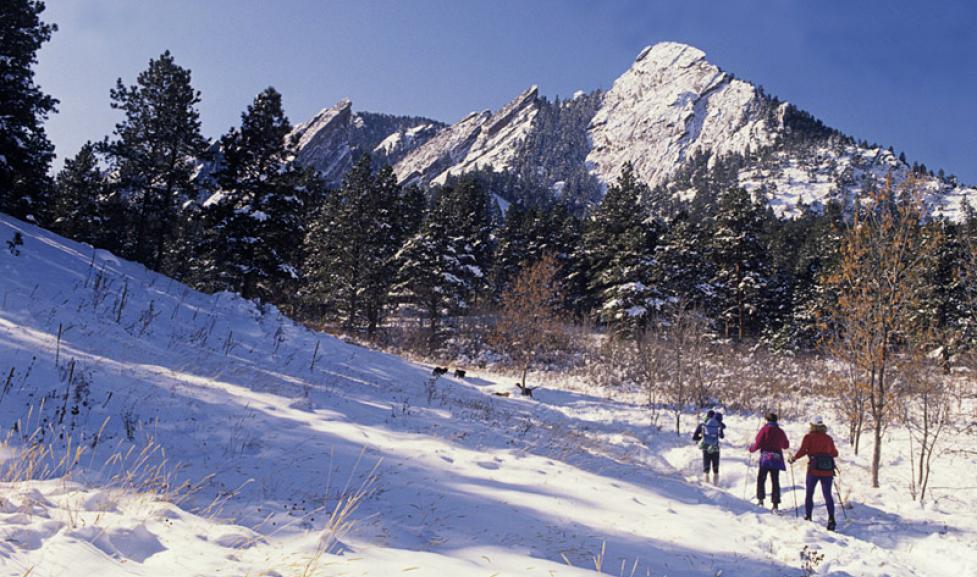Safety Essentials for Winter Hiking in Boulder
Boulder is a world-class hiking destination. On frosty winter mornings, our Compass Boulder realtors never regret strapping on their boots and heading out into the forest in pursuit of fresh air and adventure.
Most experienced hikers are familiar with the hiking safety essentials:
- Navigation
- Headlamp
- First Aid Kit
- Knife
- Fire (matches, lighter, stove)
- Shelter
- Extra food
- Extra water
- Extra Clothes
But this standard list doesn’t include winter hiking safety items. Even if you’re hitting the trails on one of Colorado’s famous unseasonably warm days, weather patterns in the Rockies can bring sudden changes in weather patterns. It’s always best to be prepared.
Items to add to your winter hiking pack:
Winter Traction
If you’re heading onto a winter trail, you must throw a pair of microspikes into your pack. No matter what the forecast predicts, you never know when conditions will turn icy. Microspikes are relatively lightweight and fit around easily around regular hiking shoes. Slipping and falling on ice is the easiest way to get injured on a winter trail. If you’re injured and cannot stay moving for warmth you risk hypothermia while waiting for help.
There are plenty of great microspike brands to choose from, but the Compass Boulder real estate agents here at Burgess Group love YakTrax for their affordability and versatility (they fit around both bulky hiking boots and sneaker-style hiking shoes!) Depending on your trail, it may also be necessary to bring crampons or snowshoes.
Hand warmers
Hands are always the first place to get numb… and the hardest part of the body to warm up. Bring a couple of pairs of hand warmers with you. Activate a pair before you even hit the trail, so when you first start feeling a tingle of numbness you’ll already have a warm respite for your fingers. If you’re using HotHands bring a couple of packs, just in case they lose their power mid-way through your trek. If you’re looking to level up your gear check out these reusable hand warmers. They’re a great zero-waste option and have up to 9 hours of battery life (and can get up to 120 degrees!).
Insulated water bottles
Experienced hikers know that you should always bring more water than you need on a hike. In winter, it’s important to carry your water in insulated vessels to avoid freezing. We love also bringing a thermos of hot tea or coffee for the journey.
Waterproof outer layer
Staying dry is crucial to staying warm. Be sure to pack your most reliable waterproof outer layer. This will protect you against any surprise snowfall or intense wind. It can also serve as a make-shift sitting pad if you need to take a break but there’s nowhere to sit that’s not covered in snow or ice.
Quick grab food
If you’ve ever hiked in freezing conditions, you know that the only way to stay warm is to keep moving. Any breaks are short and intentional. For this reason, it’s important to bring sustenance that’s quick and calorically dense. Think protein bars, energy gels, nuts, and nut butter.
An Extra Warm Layer
If you have room in your pack, our Boulder realtor team suggests bringing an extra layer of warm clothes- head to toe. But if your pack is starting to get too heavy for this, at least bring an extra hat and a pair of warm socks.
Sunscreen & Sunglasses
Sun protection is more important than ever during Colorado winter hikes. Research shows that for every 1,000 feet of elevation gain, UV rays intensify by 8-10% due to thinning atmosphere. And on top of this, the stark white of the snow is hyper-reflective. Be sure to protect your skin and eyes.
Bonus winter hiking tips:
Dress for success (No cotton!)
Dressing for success on the trail means abandoning fashion for practicality. All your layers need to be moisture-wicking. You should not be wearing anything cotton. Cotton absorbs water and takes a long time to dry out. It will lock in any sweat or moisture, making you colder and risking hypothermia. Merino wool is the best fabric for base layers. It’s warm, but lightweight, and dries quickly. However, it can be a bit expensive. If you’re going to splurge on any merino wool gear, opt for a good pair of socks.
Start early
If you’re planning a long hike, make sure to get an early start. Plot your route so that most of your hiking is happening in the warmest part of the day. Make sure you have plenty of time to get to the summit… and back… before dark. Pick a guaranteed turnaround time (whether you reach your goal or not).
Don’t forget to hydrate
This might seem obvious, but it’s easy to forget about drinking water when it’s cold outside. Plan to drink a certain amount of ounces per hour and set alarm reminders if you have to.
Leave some space in your pack
If you start out wearing all your layers, you’ll want to shed some of those layers once you start moving and work up a nice inner heat. Keeping all your layers on and getting sweaty will only make you colder later on in the day. Leave some space in your pack so you can shed layers as needed to keep yourself dry.
Know the signs of hypothermia
Symptoms include:
- Shivering
- Memory loss
- Slurred speech
- Exhaustion
- Numb hands and feet
- Shallow breathing
Pay attention to your body and to your hiking partner. If either of you starts experiencing symptoms, turn around immediately and try to warm up your core body temperature.

